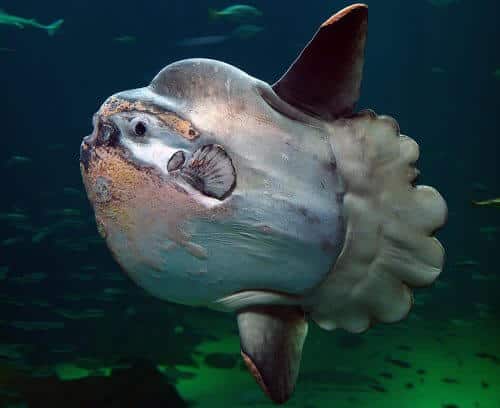The sunfish can weigh over 2 tons and is quite a rare guest in the eastern basin of the Mediterranean Sea, but recently it was captured near Ashkelon in a typical pose

By Daniel Mayer, Angle, Science and Environment News Agency
"It's been 40 years that I've been sailing at sea and I've never seen a sunfish," says Tzachi from the Ashkelon yacht rental company "The Mood", "I've never seen a fish like this anywhere else in the world and certainly not in Israel, but last Monday [January 30], on a sailing Routinely having fun with customers, we saw a particularly strange fish floating on the surface of the water near the shores of Ashkelon. At first we were sure it was a sea turtle in distress, when we got closer we already thought it might be some kind of racket or cartilaginous fish, but nothing prepared us for this huge fish swimming on its side."
Tzachi and their friends filmed the fish and sent the video to the Nature and Parks Authority, where they were told that it was an extremely rare sunfish, but with a completely normal behavior of swimming on its side on the surface of the water in order to sunbathe.
Caught in the net
The crystallized sunfish (or in its scientific name Mola mola), which was photographed at the end of January in Ashkelon, was a meter in size so it is considered a relatively young fish. According to the International Union for the Conservation of Nature and Natural Resources, the sunfish is the heaviest of the gram fish (most of the fish we know are built from a skeleton of bony bones), its average weight is 1,000 kilograms (the maximum recorded is 2.3 tons) and it can reach a diameter of up to 3.3 meters. This large fish is an ocean dweller, usually found in the upper waters and capable of diving to depths of between 30 and 480 meters. In the Mediterranean Sea, it is found mainly in the Western Sea Basin and is very rare to see in the Eastern Mediterranean Sea Basin (semesh fish was recently seen and caught on the shores of Israel in the Gaza Strip In 2013.).
His special name comes from his tendency to rise to the surface of the sea and bask in the sun, this is to accumulate high body heat before diving back into the depths. The sunfish feeds on eating jellyfish and other invertebrates, which can automatically make you like it, but its current state in the world is not promising. Although it does not have many natural enemies in the Mediterranean, the sunfish is often caught in fishing nets as by-catch and tends to eat plastic bags or become entangled in marine litter. The sunfish may be poisonous such as various swellings. Nevertheless, there is a demand for the sunfish mainly in the eastern countries where it is considered a delicacy. Its dorsal fin is also in great demand in the eastern countries and sometimes fishermen cut off the upper fin and thus leave the finless sunfish to die in the sea. Due to these reasons, but not only, the sunfish is included in the red list of species according to the International Union for Conservation of Nature and Natural Resources, one level above an endangered species.
A relationship with a seagull
"The sunfish is a cosmopolitan fish (one that is found all over the world, DM) and although it is found naturally in the Mediterranean Sea, it has always been an extremely rare fish here," says Prof. Danny Golani from the Hebrew University. "The fact that it still appears occasionally is a positive sign that the Mediterranean ecosystem is a relatively healthy one."
"The custom of the sunfish to sunbathe on the surface of the sea is a very interesting phenomenon," says Golani, who adds another and no less interesting explanation beyond the need to store heat: the development of a mutual relationship between seagulls and sunfish. A good example of this can be seen inVideo Wonderful showing how seagulls clean the sunfish. It turns out that when the sunfish approaches the surface of the sea and lies on its side, seagulls may come to the fish and gently take off the crabs that accumulate on top of the fish and thus clean it, like a pampering spa on the surface of the sea.
Many large fish have copepods (legged crustaceans of equal size and appearance) parasitic on their bodies. In coral reefs, the hankai fish work, clinging to the large fish and happily eating the parasites in a wonderful mutual relationship that provides cleanliness for the large fish and food for the hankai fish. Sunfish are flag fish (open sea fish) that are found in all oceans and are therefore also found in areas without nakai fish. But to the joy of the sunfish, the seagulls take the place of the seagulls. Even in this case both parties benefit from the transaction.
The surprising and happy appearance of the sunfish on the shores of Israel proved to us once again that although the Mediterranean Sea sometimes seems to be the less successful brother of the Red Sea, because it is mistakenly perceived by the public as desolate and boring, in fact our great sea contains a unique and rich biological diversity that should and should be preserved. If we do this, we will come back and see more sunfish swimming and sunbathing happily on the surface of the waves in the future as well.
The Sunfish near the shores of Ashkelon. Photo: Tzachi Vasnet, "The Mood":
